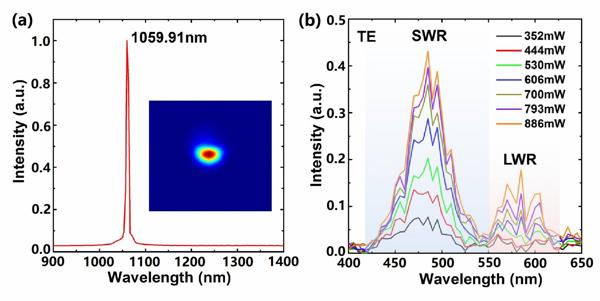An optical waveguide structure is characterized by a region with relatively high refractive index surrounded by regions with lower index. Such a configuration allows confinement of the light in small volumes with dimensions of micrometer. Benefiting from their compact size, optical waveguides have been considered to be one of the key building blocks for on-chip photonic circuits. As passive devices, waveguides can be used as optical switcher, splitter, multiplexer and coupler and so on. Meanwhile, many of the optical effects in the substrate materials has been realized in optical waveguides, such as laser oscillations or frequency conversion etc, the performances of which could be considerably enhanced due to the high intra-cavity light energy, enabling the implementations of highly efficient miniaturized and integrated platforms for a variety of photonic applications.
Femtosecond laser inscription (FLI), as one of the most efficient micromachining technology, has shown its unprecedented capabilities for 3D waveguiding device fabrication. By locally modifying the refractive index of the material through nonlinear absorption of the incident radiation, optical waveguides can be produced within the bounds of the substrate. Apart from high machining accuracy, the most intriguing advantage of FLI is its flexibility not only in term of the design freedom of waveguide geometry but also in the broad material applicability.
In past decades, Calcium fluoride (CaF2) crystals, co-doped with rear-earth ions (such as Nd3+ ions) and nonactive ions (such as Gd3+ and Y3+), have received considerable attention. As a laser host, CaF2 crystals show unique advantages including low phonon energy, high segregation coefficient allowing large concentrations of rare-earth ions, higher quantum efficiency than that of oxide when doping with rare-earth ions, broad absorption spectral bandwidth making them excellent for direct diode-pumped laser operation and broad gain bandwidth raising the prospect of developing ultra-short pulsed laser sources. Meanwhile, rear-earth doped fluoride has been considered to be an important substrate for the generation of up-converted luminescence. Although up-conversion may degrade laser performance for most traditional laser devices that rely on the down-conversion mechanism, the up-conversion technology has rapidly progressed due to its diverse applications in fields including high-level security fields, solar cell development, biological imaging, novel wavelength generation, and visible laser emission.
The research group led by Prof. Yangjian Cai from Shandong Normal University construct high-quality waveguides in Nd,Gd:CaF2 crystal that combine the above-mentioned characteristics of the substrate with the advances of WG architectures, making it possible to realize highly compacted laser and up-conversion devices based on a single wave-guiding platform and further triggering interests in their use for a broad range of integrated photonic applications. The research results are published in Chinese Optics Letters, Volume 19, No. 8, 2021 (Ruonan Li, et al., Near-infrared lasing and tunable upconversion from femtosecond laser inscribed Nd,Gd:CaF2 waveguides. Chinese Optics Letters, 2021, 19(8): 081301).
In this work, 16 tubular cladding waveguides are produced in Nd,Gd:CaF2 crystals by using FLI with different parameters. These structures, of 20 to 35 μm diameters, are inscribed with pulse energy changing from 200 to 320 nJ. Guiding behaviors of the waveguides under 633 nm are investigated. The results show that strong optical confinements under arbitrary polarizations are obtained from all waveguides. Particularly, single-mode guidance is observed from structures with relatively small diameters of 20 and 25 μm. The confocal micro-photoluminescence properties of the waveguides are further investigated, revealing that laser-induced lattice defects only occur on tracks while properties of the bulk are well preserved in the guiding volumes. Based on the waveguide with minimum propagation loss (0.87 dB/cm), waveguide lasers are realized by direct diode-pumping, showing single-mode profiles and lower lasing thresholds (98.8 mW) than that obtained from Nd,Gd:CaF2 bulk materials. Also, up-conversion luminescence of Nd3+-ions that consists of short-wavelength-range from 415 nm to 550 nm and long-wavelength-range from 550 nm to 625 nm are achieved in the waveguide. The intensity ratios of two wavelength ranges are proved to be tunable through changing the pumping polarizations.
Prof. Yangjian Cai from Shandong Normal University believes that the waveguides fabricated in this work are promising for constructing miniature devices and integrated optical circuits for the 1-μm and visible optical applications.

(a)Spectrum of waveguide laser at 1059.91 nm with single-mode profile. (b)Up-conversion spectra obtained from the waveguide consist short-wavelength-range from 415 to 550 nm and long-wavelength-range of 550 to 625 nm.


